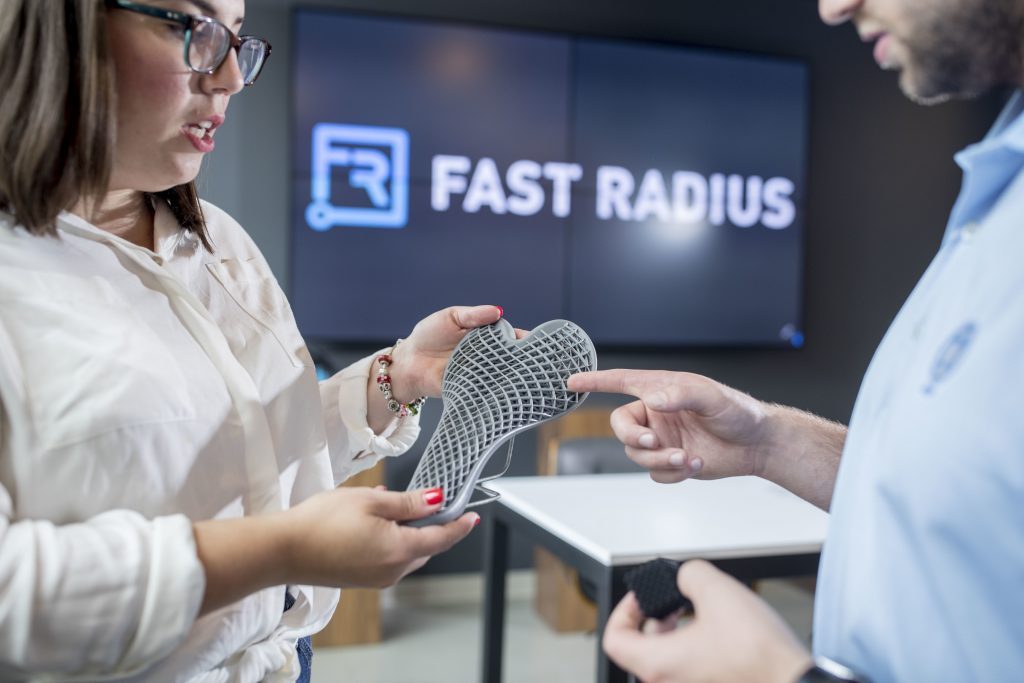The month of July was an active one for 3D printing investments and SPAC deals, with announcements from Fathom Digital Manufacturing, Fast Radius, and Markforged. Desktop Metal and Essentium acquired businesses, while 3D Systems and Renishaw made headlines for selling them. The world of construction 3D printing also came to life with several ‘world first’ milestones from companies such as MX3D, Twente Additive Manufacturing, and COBOD.

The SPAC merger surge continues
On-demand manufacturing firm Fathom Digital Manufacturing announced plans to go public via a merger with Special Purpose Acquisition Company (SPAC) Altimar Acquisition Corp. II. The deal will see Altimar combine with Fathom to form a $1.5 billion company backed by $80 million in funding. The company stated that it would use the new capital to scale its production capabilities and accelerate inorganic growth.
Elsewhere, digital manufacturing service provider Fast Radius announced plans to go public via a merger with SPAC ECP Environmental Growth Opportunities (ENNV). The joint firm was expected to be valued at around $995 million, with Fast Radius shareholders enrolling 100% of their equity. Any funding raised via the deal has been earmarked for bankrolling the firm’s ongoing software development and facility expansion strategy, in the hopes of boosting its annual revenue up to $635 million by 2025.
“We are excited to partner with ENNV, as their team’s long track record of success, history of being on the forefront of new sustainable infrastructure transitions, and their institutional reach will accelerate the next chapter of our growth,” said Lou Rassey, CEO of Fast Radius. “Our board and management team remain committed to executing on our proven business model and driving value for all stakeholders.”
Finally, metal 3D printer manufacturer Markforged began trading its shares on the New York Stock Exchange (NYSE). The combined enterprises, united under the ‘Markforged Holding Corporation’ banner, were valued at $2.1 billion. In going public, Markforged raised $361 million in gross proceeds, which it has since been using to fund the ongoing expansion of its product portfolio.
“As a publicly-traded company, we will continue to focus on executing on our ambitious product roadmap and further accelerating innovation, expanding customer adoption, and capitalizing on the strong secular trends in AM,” said Shai Terem, President and CEO of Markforged. “This will allow us to bring our platform to even more manufacturing floors around the world for mission-critical use cases.”

Acquisitions and sales in the additive manufacturing sector
July was also home to several pieces of major acquisition news, with 3D printer manufacturer Desktop Metal announcing the acquisition of Belgian recoating technology developer Aerosint. The latter’s Selective Powder Deposition technology allows users to 3D print multiple materials simultaneously, unlocking powder efficiency, cost savings, and throughput gains. Having now bought the company, Desktop Metal intends to steadily integrate this multi-material process into its own offering, while allowing the firm to operate independently as a fully-owned subsidiary.
“This transaction advances our strategy to own differentiated print technologies that enable an expanding set of AM 2.0 applications at scale,” said Ric Fulop, Founder, and CEO of Desktop Metal. “Today people print parts, but in the future, people will look to print full products, which may be composed of multiple materials. Multi-material printing is the next frontier in additive manufacturing.”
Similarly, Essentium, the 3D printer manufacturer behind the High-Speed Extrusion (HSE) 3D printing platform, signed a Letter of Intent to acquire Collider, the developer of the ‘Programmable Tooling’ hybrid additive manufacturing process.
Collider’s technology combines DLP 3D printing with injection molding, providing manufacturers with an avenue for low-volume, high-strength part production. The deal will grant Essentium full access to Collider’s IP portfolio, enabling the company to make its debut in the resin-based DLP 3D printing market.
We also saw 3D printer manufacturer 3D Systems sell its medical simulation software division Simbionix in a deal worth $305 million. Simbionix was bought by medical VR training firm Surgical Science Sweden, where it now supplements the firm’s existing clinical simulation program portfolio. For 3D Systems, the move was a step towards the restructuring it started last year, whereby it divested many of its non-core businesses in order to establish a “singular focus” on 3D printing.
“Over the last several months, 3D Systems has divested a number of assets that are not core to our industry-leading additive manufacturing solutions business,” said Dr. Jeffrey Graves, President, and CEO of 3D Systems. “The final of these is our Simbionix business, under the leadership of Ran Bronstein, which has secured a strong position in the medical simulation, training, and robotic surgery market.”
Finally, the largest shareholders of UK-based engineering firm Renishaw abandoned an attempt to sell their shares after failing to find a suitable buyer. Since putting their combined 53% stake up for sale in March 2021, the company’s Chairmen Sir David McMurtry and John Deer were unable to find a bidder that met their stringent criteria, despite receiving several proposals. The company has since remained under its current owners.
“At the start of this process we made it very clear that, with the board, we were focused on ensuring that we find the right new owner for our business,” said McMurtry and Deer. “Whilst the formal sale process didn’t result in a new owner for Renishaw, we are satisfied that it ensured a thorough and rigorous process that enabled us to evaluate a wide range of potential buyers.”

World firsts in construction 3D printing
Interestingly, July also seemed to bring about a number of important milestones in the construction 3D printing sector. In Malawi, Africa, what is thought to be the world’s first 3D printed school opened its doors to students. Printed in just 18 hours, the school was built using a concrete printer from Danish construction firm COBOD as part of a project with 14Trees, a joint venture between building materials specialist LafargeHolcim and CDC Group, the UK’s publicly owned impact investor.
Elsewhere, in Canada, the 3D printed ‘Fibonacci House’ became the first additively manufactured home to be listed on the popular travel-lodging site Airbnb. Built by Dutch start-up Twente Additive Manufacturing, the compact yet luxuriously-upholstered holiday home is now available for rental in the scenic hills of British Columbia. Inspired by the Fibonacci Sequence, the structure features the golden math ratio often found in nature.
Over in the Netherlands, Her Majesty the Queen Máxima and metal 3D printing technology developer MX3D unveiled the country’s first 3D printed stainless steel bridge in the heart of Amsterdam. The 12.2m-long structure has now been placed over the Oudezijds Achterburgwal, one of the oldest canals in the city’s red light district, and is ready for use by pedestrians and cyclists.
Tim Geurtjens, co-founder of MX3D, said, “A few years ago, we came up with the idea to use the robotic 3D metal printers that we developed to print a functional full size steel bridge. Together with the excitement of this crazy idea also came the realization that there was no way we could pull this off alone. For a complex and crazy project like this to succeed, you need many smart and enthusiastic people.”

Subscribe to the 3D Printing Industry newsletter for the latest news in additive manufacturing. You can also stay connected by following us on Twitter, liking us on Facebook, and tuning into the 3D Printing Industry YouTube Channel.
Looking for a career in additive manufacturing? Visit 3D Printing Jobs for a selection of roles in the industry.
Featured image shows traders looking up at a Markforged sign outside the NYSE. Photo via Markforged.


